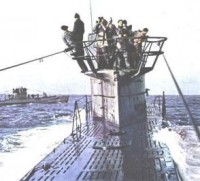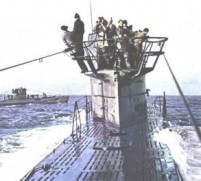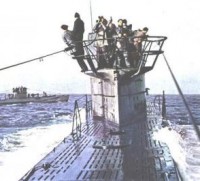U BOATS SUNK IN SOUTH ATLANTIC - U 128 / U 1062
42)U-801 LAST PATROL
DEPARTURE FROM LORIENT
U-801 left Lorient at 1730 on 26 February 1944. With the exception of a mine destructor vessel, which proceeded ahead, she was alone. Some time after passing the mole the two ships were joined by a small minesweeper which took up station astern of the U-boat. Apart from the later obvious fact that U-801 was to operate in the south, the crew, with the exception of the officers had no idea of the exact area intended.
A petty officer, however, quoted the Quartermaster as saying that they would proceed first to Ivory Coast. At 0100 on 27 February U-801 carried out a deep diving test and her escort turned back. For a number of hours the U-boat proceeded submerged, then surfaced in order to charge her batteries.
At nightfall on 27 February U-801 surfaced and released an R.D.S. Two hours later, before submerging she released another. Before dawn the U-boat surfaced again and followed the same procedure with her R.D.S. On the next 3 nights U-801 either surfaced for a period of 4 hours in the middle of the night or for 2 hours after dark and again before dawn. On each occasion R.D.S. were released so that when the Bay area had been passed all 15 R.D.S. had been expended. A signal was then made to Control reporting that the U-boat had made a safe passage of the danger area.
MADEIRA SIGHTED
After steaming clear of the bay area the strict diving routine was increasingly relaxed. At first it was only at night that the hours on the surface were increased, but as U-801proceeded on her southerly course she surfaced increasingly by day. Some 10 days out of Lorient the U-boat was on the surface one night when less than a mile away, on the port bow, a lighthouse was sighted and the coast of Madeira came into sight. After passing Madeira U-801 spent several hours of daylight and all nights on the surface. So far the patrol had been entirely uneventful.
THE SINKING
On 15 March the Junior Officer, Kempkes, persuaded Brans that the area was safe enough to start some gunnery practice. In spite of the fact that gunnery practice is at all times forbidden and in face of outspoken reluctance on the part of the crew Brans agreed and some practice firing was carried out.
In the late afternoon on the following day, 16 March, U-801 was proceeding untroubled over glassy seas, having just completed some practice firing. Some 12 to 15 of the crew were topside changing watch. Suddenly an aircraft alarm was given and two planes were reported dead astern at a height of about 500 meters. There had been several practice alarms that afternoon so that the crew did not at first pay overmuch attention. The 37-mm. was partially dismantled for servicing and the gun crews did not have sufficient time to load and man the lighter weapons before a pursuit plane dived down on the U-boat out of the sun and started raking the superstructure and decks with cannon fire. Doubling back sharply after its first attack the aircraft poured a further hail of shell into the U-boat and then made off. (O.N.I. Note: At 1822 GCT a fully surface U-boat on course 250°, making from 8 to 12 knots was sighted simultaneously by a TBF1-C and an FM2 from U.S.S. BLOCK ISLAND. At 1826 and again at 1827 a strafing attack was delivered by the FM.) U-801 had suffered considerable damage.
Nine of the crew who were topside at the time of the attack were wounded and one was killed outright. The barrel of one 20-mm. was shot to pieces and the after part of Platform II in the vicinity of the ammunition containers was burning fiercely. This, apart from various penetrations of the superstructure, appeared at the time to be the sum total of the damage sustained.
As soon as the casualties could be brought down the hatch U-801 submerged. At a depth of some 25-30 meters one loud and two lesser explosions were heard which appeared to the crew of the U-boat something like the detonation of hand grenades. No damage was caused internally and depth was increased to about 60 meters (O.N.I. Note: At 1827.2 the TBF dropped depth charges which over-shot the target. At 1828 the U-boat was seen to submerge. At 1832.5 the TBF attacked again with depth charges but observed no explosions).
U-801 REPORTS DAMAGE TO CONTROL
At about 2000 the same evening U-801 surfaced and immediately signaled Control that she had been attacked, suffering casualties and damage. A meeting with a supply U-boat (Burghagen or Studt) was arranged for 20 March and it was requested that this be put forward in order that the casualties might be handed over for medical attention. A further inspection of the damage on surfacing indicated that the detonations heard after submerging had been caused by the explosion of one or more ammunition containers as a result of the fire which broke out on Platform II. U-801 had not been long on the surface when a G.S.R. Naxos contact was obtained and the U-boat submerged again to about 60 meters.
OIL TRACED NOTED
Within 20 minutes U-801 was again on the surface where she remained for 2 hours charging batteries. It was now that a strong smell of fuel oil was noticed by those on deck which led to the discovery that U-801 was leaving an oil trace, apparently caused by damage to one of her fuel tanks in the recent aircraft attack.
U-801 PREPARES TO ATTACK
While on the surface torpedo tubes 2, 5 & 6 were prepared for the firing of T-5 torpedoes and shortly before submerging 2 or 3 R.D.B. were released. The torpedo tubes had not long been ready when Brans thought that he would have a chance to use them. Shadows were reported astern. Although Brans was proposing to remain at periscope depth, he was, as on other occasions, persuaded by Schumann to submerge and for the next half hour U-801 remained at a depth of from 60 to 100 meters. The U-boat had just reached the surface again when Brans, after one look through the periscope, leaped down the conning tower in a state of great excitement saying that the U-boat was illuminated by aircraft flares.
HUNT BY SURFACE CRAFT BEGINS
U-801 submerged once more to about 60 meters and did not surface again until the following day. At intervals throughout the night the crew of the U-boat heard buzzing noises quite close and, therefore, realized that they were now being hunted by surface craft. There was otherwise no indication of the presence of surface craft.
U-801 IS ATTACKED BY DEPTH CHARGES
At about 0500 on the following morning 17 March U-801 was proceeding at a depth of 70 meters. The buzzing sound had been audible for quite a while when a loud report, followed by 5 explosions, shook the U-boat. Water entered rapidly and before long the floor plates in the Diesel compartment were awash. An investigation showed that a hole, 15-20 cms. long and 2 mm. wide had been torn in the Diesel compartment pressure hull. U-801dropped down to about 200 meters. At this depth screw noises were picked up on the hydrophones and the buzzing sound persisted.
Note: At 0427 T8 made a radar contact which turned out to be a periscope. The plane attacked with depth bombs but no evidence was obtained.
U-801 ATTACKED AGAIN AND FORCED TO SURFACE
For some 7-8 miles U-801 proceeded submerged gradually sinking to a greater depth which at one point was estimated at 300 meters. After a number of hours she was once more attacked by depth charges. The first 4 attacks caused no further damage but following the 5th attack either the main or the auxiliary bilge pump and auxiliary switchboard 3 were put out of action. (O.N.I. Note: At 0755 on 17 March an aircraft sighted an oil slick which was trailed. At 1000 Sonobuoys gave definite submarine indications, and smoke floats were dropped along the slick in order to guide the approaching U.S.S. CORRY. Eight depth charge attacks followed.
As a result of the additional damage Brans decided to surface but found difficulty in keeping his U-boat in trim. She was always stern heavy. On reaching 80 meters, further depth charges were heard. Realizing that hunting craft in unknown numbers must be very close at hand Brans decided that the only possible way of escape lay in offensive action. Tubes 2 and 6 were readied for firing on reaching periscope depth but it was discovered that the attack periscope telemotor system had failed. Brans realized that they were in a hopeless situation. At about 1310, U-801 surfaced and the order to collect the wounded prior to abandoning ship was given. (O.N.I. Note: CORRY made her final attack at 1314. Four minutes later the submarine surfaced and was sunk by the combined gunfire of CORRY and BRONSTEIN.)
U-801 ATTACKED ON THE SURFACE AND SUNK
A scene of the most appalling disorganization and devastation ensued. Within the U-boat the order to abandon ship never reached the bow compartment where members of the crew only realized that the end had come when they say the telegraphists destroying their secret equipment. Brans was first on the bridge and after him were hoisted the wounded. The quartermaster followed with the two line officers after him.
The surface craft immediately opened a very accurate fire and as the first of the men reached the bridge they saw Brans hanging like a corpse over the night firing stand. The quartermaster, lying at his feet, was a ghastly headless figure. At least 2 other lay dead. The line officers Buschmann and Kempkes were the first overboard, regardless of the fact that the captain was dead and that there were wounded to evacuate.
It was Schumann, the engineer and would-be captain who took control. On reaching the bridge he lit a cigarette and stood there quite unperturbed until the last man to reach the bridge had abandoned ship and the wounded had been successfully evacuated. He was last seen going down the hatch to join a control room petty officer in the scuttling duties. Some five minutes after surfacing U-801 sank stern first. No scuttling charges were fitted.
By Jerry Mason Capt. USN Ret. www.uboatarchive.net



